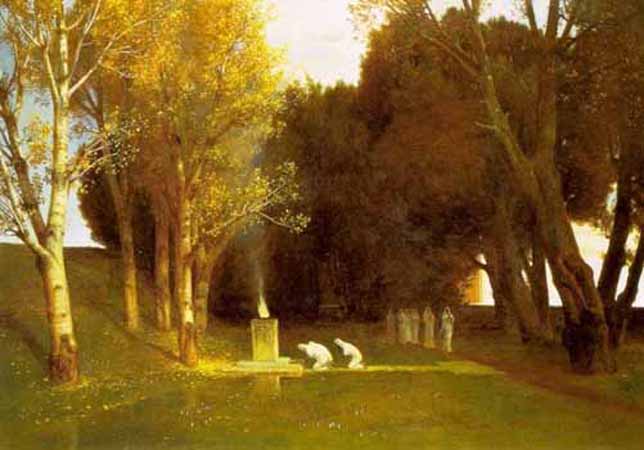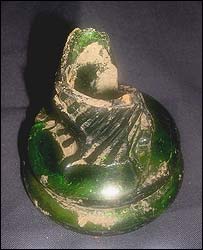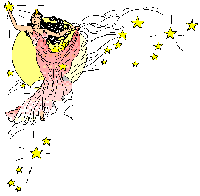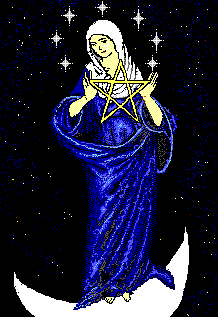
Bide within the Law you must, in perfect Love and perfect Trust.
Live you must and let to live, fairly take and fairly give.
For tread the Circle thrice about to keep unwelcome spirits out.
To bind the spell well every time, let the spell be said in rhyme.
Light of eye and soft of touch, speak you little, listen much.
Honor the Old Ones in deed and name,
let love and light be our guides again.
Deosil go by the waxing moon, chanting out the joyful tune.
Widdershins go when the moon doth wane,
and the werewolf howls by the dread wolfsbane.
When the Lady's moon is new, kiss the hand to Her times two.
When the moon rides at Her peak then your heart's desire seek.
Heed the North winds mighty gale, lock the door and trim the sail.
When the Wind blows from the East, expect the new and set the feast.
When the wind comes from the South, love will kiss you on the mouth.
When the wind whispers from the West, all hearts will find peace and rest.
Nine woods in the Cauldron go, burn them fast and burn them slow.
Birch in the fire goes to represent what the Lady knows.
Oak in the forest towers with might, in the fire it brings the God's
insight. Rowan is a tree of power causing life and magick to flower.
Willows at the waterside stand ready to help us to the Summerland.
Hawthorn is burned to purify and to draw faerie to your eye.
Hazel-the tree of wisdom and learning adds its strength to the bright fire burning.
White are the flowers of Apple tree that brings us fruits of fertility.
Grapes grow upon the vine giving us both joy and wine.
Fir does mark the evergreen to represent immortality seen.
Elder is the Lady's tree burn it not or cursed you'll be.
Four times the Major Sabbats mark in the light and in the dark.
As the old year starts to wane the new begins, it's now Samhain.
When the time for Imbolc shows watch for flowers through the snows.
When the wheel begins to turn soon the Beltane fires will burn.
As the wheel turns to Lamas night power is brought to magick rite.
Four times the Minor Sabbats fall use the Sun to mark them all.
When the wheel has turned to Yule light the log the Horned One rules.
In the spring, when night equals day time for Ostara to come our way.
When the Sun has reached it's height time for Oak and Holly to fight.
Harvesting comes to one and all when the Autumn Equinox does fall.
Heed the flower, bush, and tree by the Lady blessed you'll be.
Where the rippling waters go cast a stone, the truth you'll know.
When you have and hold a need, harken not to others greed.
With a fool no season spend or be counted as his friend.
Merry Meet and Merry Part bright the cheeks and warm the heart.
Mind the Three-fold Laws you should three times bad and three times good.
When misfortune is enow wear the star upon your brow.
Be true in love this you must do unless your love is false to you.
These Eight words the Rede fulfill:
"An Ye Harm None, Do What Ye Will"
Aside from the Wiccan Rede and the "three-fold law", Wiccans do not have to subscribe to a fixed ideology so beliefs vary, however the common theme is that Wiccans gain a connection with the divine spirit of mother nature through the celebration of her cycles through the Wicca calender. This is done either individually or with other Wiccans.
According to most versions of the three-fold law, whatever one does comes back to one thrice-multiplied, in amplified repercussion. One short, rhymed version of the Wiccan Rede states "Eight words the Wiccan Rede fulfill: An it harm none, do what you will." Often "none" is interpreted to include the doer him self in analogy to the "golden rule" of other faiths. There are no universal proscriptions regarding food, sex, burial or military service and Wiccans, as a rule, discourage proselytizing (attempts to convert others to a different religion).

At key points in the year Wiccans gather and connect with nature, generally by forming a circle, sometimes using set forms of words, or otherwise improvising according to the participants needs.
The morality of wicca is based heavily on free will allowing individual freedom with as little interference as possible. There is high level of equality in Wicca with the emphasis on the circle and the lack of any preaching. The concept of a talking stick where everyone has their say is more widespread than dominating leaders. The emphasis is on the creation of harmony by allowing the individual to do their own will but encouraging them to think of the harm done to others by the exercising of this freedom.
In order to understand Wicca it is essential to know its roots. All countries have a native spiritual tradition based around reverence for the forces of nature. Wicca is the native tradition for the nations of England, Scotland, Ireland, and Wales, and is rooted in the period before 500 BC which marks the start of the iron age. The sacred sites from this period, in particular Avebury/Silbury and Stonehenge, are important to Wicca as are the ancient British legends, for example the Mabignogian. Wicca was illegal in Britain for nearly 1000 years up until 1951, however following it's legalization a large amount of material has been published and Wicca is now accessible to all.
Wicca has its own art, including jewelry, and also has a deep understanding of the power of plants, in particular the influence of their fragrances. Many Wiccan also use crystals, both for their natural beauty and for their spiritual power.
Wiccan jewelry includes earrings, pendants and necklaces which often contain precious stones with particular meaning and Wiccan symbols. Crystals give power to the wearer.
Wicca is a Neo-Pagan religion based on the pre-Christian traditions of England, Ireland, Scotland, and Wales. Its origins can be traced even further back to Paleolithic peoples who worshipped a Hunter God and a Fertility Goddess. Cave paintings found in France (and dated at 30,000 years old) depict a man with the head of a stag, and a woman with a swollen, pregnant belly. They stand in a circle with eleven mortals. These archetypes of the divine are worshipped by Wiccans to this very day. By these standards, the religion that is now called Wicca, is perhaps the oldest religion in the world.
In 1951, the laws against Witchcraft were repealed in England. A man named Gerald Gardner was the first to come into the public eye with description of what modern witches were practicing. His information came from the traditions of a coven called the New Forest Witches, and from Ceremonial Magick and the Kaballah. He began what is now called the Gardnerian Tradition of Wicca. From Gardnerian came Alexandrian Tradition and a host of other offshoots that today number in the hundreds.
Wicca is based on a deep respect for nature and the certain knowledge that we do not have the right to exploit it for our own gain. Wiccans are deeply concerned with conservation and ecology, and as in all Neo-Pagan religions.
Wiccans believe that both animate and inanimate objects possess a spirit which forms part of the Whole. Spirit is that essence which every object possesses linking it to nature.
Wicca is a celebration of the life-forces of nature as personified by the Goddess and her consort, the Gods.
Some Wiccans see their inspiration and traditions as coming directly from the gods. Certain Wiccan mythology holds that Wicca has come down from the stone age, surviving persecution in secret covens for hundreds of years.
Others say that their Wicca is a long-held family tradition (or "fam trad"), passed down through villages and grandmothers. Aidan Kelly argues that modern Wicca was largely pieced together by Gerald Gardner from Margaret Murray, Charles Leland and other sources, with significant revisions by Doreen Valiente (and others), beginning in 1939.
Whatever its origins, Wicca today is a vibrant, modern religion, open to change, creativity and personalization. Wicca is different than the religions of the ancient people, but it embraces some of the same beliefs. Wiccan's have a common belief that the Earth is Sacred and the animals that dwell on it are sacred as well. Wicca or Witchcraft, Paganism, High Magic and other forms of Occultism are not Satanism. Satan is a belief of Christianity.


January 28, 2004 - BBC News
A chilling reminder of our superstitious past has been unearthed from a rural farmhouse.
The "witch bottle" was discovered buried in old foundations in the Lincolnshire village of Navenby.
Containing bent pins, human hair and perhaps urine, the bottles were supposed to protect a household against evil spells.
Dated to about 1830, it is evidence the fear of dark forces persisted far longer than previously thought.
Discovered by accident during building work, the artefact initially sat unrecognised in a cupboard. Jo Butler, the house's owner, described what they found.
She said: "The builder was breaking up foundations with a pick and he came across the bottle.
"We saw it contained metal bits and this kind of strap but had never heard of witch bottles and put it under the stairs."
It was only recognised when taken to a open evening held by the archaeology department of Lincolnshire County Council.
Finds Liaison Officer Adam Daubney first identified the artefact.
He said: "It was an incredible moment. It was the first one I had physically seen and they are really quite rare artefacts, so to have that handed in was quite something."
The "bottle", in this case more likely to have been a glass inkwell or candlestick, had been damaged during discovery but still had its contents.
Mr Daubney said: "It seems a bit like voodoo, using human hair and pins but it's not entirely clear why these items where used.
"One theory is that the pins were put in urine so when the witch went to the toilet, it felt like they were passing the sharp metal.
"What the bottles were intended to do was bounce back spells on the sender.
"Even if you did not know who the witch was, you would make one of these and sit back to see who died, then that person was the witch."
Death sentence
Britain in the late 1500's, and for 100 years after, was gripped by the "Witchcraze".
This saw hundreds of women persecuted and sometimes executed, for alleged involvement in black magic.
The most famous British trials were at North Berwick, in Scotland, in 1591 and Pendle, Lancashire in 1612.
Most "witches" were hanged, rather than the burning at the stake of popular imagination.
Protecting hearth and home from such malignant forces took various forms, including putting shoes beneath the floorboards and walling up cats.
Witch bottles, often made from stoneware, were most common in the 1600's, at the height of the witchcraft scares.
The Navenby example, however, has been dated at 1830, a time when such beliefs were thought to have been dying out.
"This late date is really incredible," said Mr Daubney. "Such traditions do tend to linger in more rural areas like Lincolnshire and Norfolk but this is very rare."
He added: "It could be either that the people who made this really believed in witches or it could be a kind of harmless tradition, a little like throwing salt over your shoulder.
"But the care with which this has put together, with a leather strap to hold it, could suggest the former."
The bottle is being conserved and will go on display at the Museum of Lincolnshire Life in Lincoln later this year.


Although some Wiccans focus on particular gods from particular world mythologies, Wiccans may worship many god(goddesses)s by many different names. Most worship some form of the Great Goddess and Her consort, The Horned God. Such duo-theistic forces are often conceived as embodying complementary polarities, not in opposition. In some traditions worship of the Goddess is emphasized, although in others the Goddess and God are seen as complementary co-equals.
The Goddess and God may be seen as associated with certain things (such as the Goddess with the earth or moon, God with sun and wildlife, etc), but there are no hard and fast rules. Some traditions worship the Goddess alone while others see Divinity as essentially beyond human understanding, with "Goddess" and "God" simply a convenient shorthand.
Some ritual items are common to almost every Wiccan tradition, such as the athame (ritual knife) and chalice (ritual cup). Others may be used by some traditions but not others: bells, brooms, candles, cauldrons, cords, drums, incense, jewelry, special plates, pentacles, scourges, statues, swords, staves and wands.
The meaning of these items, their use and manufacture will differ among traditions and individuals. Usually a Wiccan ritual will involve some sort of creation of sacred space (casting a circle), invocation of divine power, sharing of dance/song/food or wine and a thankful farewell and ceremonial closing. Rituals may be held at Wiccan "sabbats" or "esbats" or to mark life transitions such as births, coming-of-age, marriages/handfastings, housewarmings, healings, deaths or other rites of passage.
Most Wiccans mark eight holiday "sabbats" in the "wheel of the year," falling on the solstices, equinoxes and the four "cross-quarter days" on or about the first of February, May, August and November. The names of the sabbats may differ between traditions, and many Wiccans also mark "esbats," rituals for worship in accordance with a given moon phase (such as the night of the full moon).
Although there is no one source for all Wiccan liturgy, many liturgical items such as the methods for casting the circle, the "Charge of the Goddess," certain myths and expressions are common to many traditions.

Some common expressions include "hail and welcome/farewell," "blessed be and the closing "Merry meet and merry part, and merry meet again."
There is no one bible or book of common prayer for all Wiccans, however, and great value is placed on creativity, poetry and the artful integration of different myths and ritual elements.
Some myths and associations are common to many Wiccan traditions, such as the Goddess' giving birth to the Horned God, the theme of their courtship and His death, the descent of the Goddess into the realm of death and others.
Another theological point held in common by many Wiccans is the immanence of deity/divinity within the natural world, self and cycle of the seasons. This places value on the earth and this world, as distinguished from views of transcendent divinity and creation.
Wiccans as a whole are very much "into" cycles: of life, of the moon and seasons. Cyclical change as an erotic dance of life, death and rebirth is a popular theme in Wiccan imagery, ritual and liturgy.
Although it may be foolhardy to compare things as complex as religions, people do. Many Wiccans distinguish themselves from Satanists, for example, in preferring complementary views of divinity to adversarial ones. Others may note their own comfort and embrace of ambiguity and polytheism (many gods).
Unlike the Jewish, Christian or Islamic traditions, there is little emphasis on interpretation of "scripture" or a revealed text. Although many Wiccans may believe in some sort of reincarnation, they may distinguish themselves from Buddhists in seeing life as a journey or adventure without any desire to "leave the wheel" of return.
Like Hindus, Wiccans may pride themselves on their tolerance for other paths, like Buddhists they may value personal insight and like Taoists they may seek to align themselves more perfectly with nature. Some Wiccans may separate themselves from the "New Age" in their value for both "light" and "dark" aspects of existence, a do-it-yourself attitude and a distrust of money or hierarchies of enlightenment.
Can I be a Christian/ Jew/ Muslim/ Buddhist/ Taoist/ Astrologer/ Druid/ Shaman/ omnivore/ whatever and a Wiccan? Since much of Wicca is more world view and ceremonial practice than anything else, there is no Wiccan proscription of such things. Most traditions have no requirement to denounce any other faith and, indeed, Wiccans often look askance at "one true wayism" which claim to have a monopoly on truth, divine revelation or enlightenment. "Christian Wiccans" probably face the largest skepticism, however, given the history and ongoing reality of allegedly "Christian" persecution.
Prejudice (fear of job-loss, child-custody challenges, ridicule, vandalism and even violence) may still keep many Wiccans "in the broom closet," with concealment and dual observances a traditional Wiccan defense against persecution. This may make contact with Wiccans difficult in some areas. Since Wiccan worship is fairly active by its nature, non-participating observers are rarely invited to Wiccan rituals.
Usually "dedication" ceremonially marks the beginning of Wiccan study, while "initiation" may mark full membership in a coven/tradition (such as after "a year and a day") or may indicate elevation in skill or to special clergy status. Some traditions look on all initiates as co-equal clergy, while others have grades or "degrees" of initiation, which may be marked by distinct sacramental ceremonies, duties or expectations within the tradition.
Almost all Wiccans, however, have some sort of ceremony or psychological practice to better attune themselves with divinity, encouraging insight and a sense of efficacy. Others may cast love spells or other curses.
Some Wiccans call themselves "Witches," capitalizing it as a gesture of solidarity with the victims of the Burning Times, but this is a personal decision. Although many Wiccans today may cast spells and practice magick, these are not considered an integral part of Wicca by all Wiccans. Wicca is not traditional folk magic and all magic is not necessarily Wiccan, anymore than all people who pray belong to any particular religion.
"The Burning Times" is the term used by many modern Neo-Pagans and feminists to refer to the great European witch-hunts of the early modern period, coincident with the time of the reformation and seen by many as a crucial step in Christianity's crushing of the Pagan religions, driving these underground. Some authors claim as many as ten million people were killed in these hunts, while more recent scholars put the number of documented deaths at 20-100 thousands, 80-90% of these women. Sometimes these numbers are doubled to account for non-judicial killings and deaths from torture, suicide, etc. Whatever the numbers, however, victims of these hunts are perceived as martyrs by Wiccans today, with the lessons of intolerance, misogyny and religious terror clearly noted.



CRYSTALINKS MAILING LIST, NEWSLETTER, UPDATES